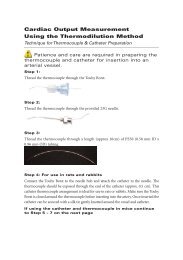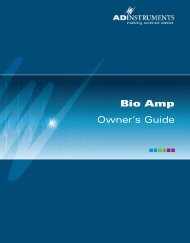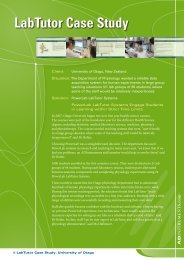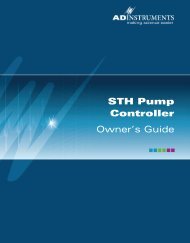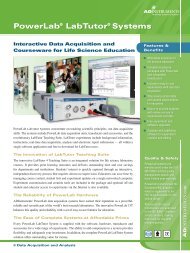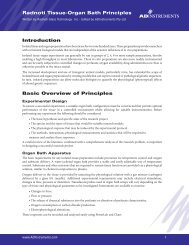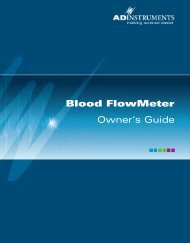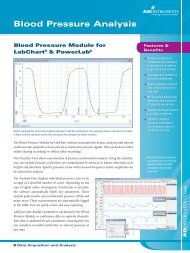NIBP Controller Owner's Guide - ADInstruments
NIBP Controller Owner's Guide - ADInstruments
NIBP Controller Owner's Guide - ADInstruments
Create successful ePaper yourself
Turn your PDF publications into a flip-book with our unique Google optimized e-Paper software.
Users are presented with all the information that is typically recorded by <strong>NIBP</strong><br />
systems and can implement their own algorithms.<br />
The following guidelines are provided to assist in the development of<br />
protocols and reliable algorithms for the non-invasive measurement of blood<br />
pressure in small animals.<br />
Protocol Development <strong>Guide</strong>lines<br />
1. Training: Most animals require some training, habituation to the protocol,<br />
and careful handling to produce repeatable results; rats are more readily<br />
trained than mice. Two to three training sessions may be necessary to<br />
acclimatize the animals. Even when the animal has been trained it may<br />
take a few minutes before a distinct pulse is measurable on the tail.<br />
2. Restraint cages: These are necessary for conscious animals. Ensure that<br />
Perspex restraint cages are selected to fit the animal comfortably. Place the<br />
animal in the Perspex cylinder restraint cage and adjust the depth to<br />
restrict forward and backward movement within the tube. The tube<br />
should prevent the animal from turning around.<br />
3. External stimuli: Sudden motion and sounds should be restricted as much<br />
as possible, since they cause animal movement. It sometimes helps to<br />
cover the restraint cage with a cloth to reduce the impact of external<br />
stimuli.<br />
4. Temperature maintenance: Warming rats and mice improves blood<br />
circulation in the tail and the signal to noise ratio in the recording.<br />
Typically animals should be preheated to 28–30 °C and maintained at that<br />
temperature during the test.<br />
5. Tail cuff: The tail cuff is used to occlude blood flow in the tail and thereby<br />
interrupt the pulse that is measurable in the caudal artery. The tail cuff is<br />
positioned at the proximal end of the tail.<br />
6. Pulse transducer positioning: The active site of the pulse transducer<br />
should be located on the ventral surface of the tail, directly below the<br />
caudal artery. The transducer is positioned directly following the tail cuff.<br />
Maximum sensitivity is achieved when the artery is positioned above the<br />
most sensitive position on the transducer. Movement from this position<br />
can reduce the amplitude of the measured pulses.<br />
7. Mechanical vibrations: The transducer used to make the pulse<br />
measurements is very sensitive and subject to vibrations. Ensure that<br />
mechanical vibrations from other laboratory devices do not affect the<br />
transducer.<br />
22<br />
<strong>NIBP</strong> <strong>Controller</strong> Owner’s <strong>Guide</strong>



